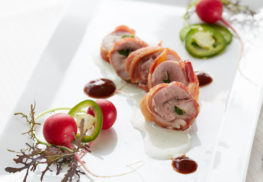At a Water Hole

The dirt road took us 30 miles from the highway, around a mountain, through a large basin, and then up to a long, treeless plateau. A cloud of dust billowed far behind our rig, marking our progress through the desert.
We found water—at last—in a lake that shrunk over the summer and now was little more than a mud puddle. A one-room cabin stood by this water hole and we parked close by, looking through the windows at a structure now inhabited only by pack rats. A dry field, once planted in grain, surrounded the little lake and cabin. A sea of sage stretched in all directions.
This was an important mud puddle, we found as we walked its perimeter. Cattle, antelope, rabbits, coyotes, and sage grouse sign cluttered the soft mud surrounding the water.
We were here for sage grouse, having drawn controlled-hunt tags for this unit. It was the middle of the afternoon on our only day to hunt these birds in a five-day season. We had traveled all day, searching for water. Now that we had reached our destination, we could either take a nap in the sun and wait for the birds to come to us or we could go after them, and flush them from the sage. The decision was easy.
Rich walked east and I headed into the sun. Hunting without dogs this time, we had to concentrate on the likeliest cover, walking in zigs and zags. A few small birds flew ahead of me, low over the tops of the sage. I turned to see how Rich was doing and watched him suddenly swing his shotgun through the air, the sunlight glinting from the twin barrels.
A grouse was in the air and I heard the thump of his gun. He made a single shot and the bird was down. From a distance I watched while he retrieved it and lifted it above his head to show me. He put the bird in his game bag and continued east while I again headed west. His gun spoke again after a few minutes. Two distant thumps as two more birds lifted into the air and made their escape. We joined forces again after awhile. Rich cleaned his bird, a young female. We hunted into the evening together, walking 20 to 30 yards apart.
Where the sage met a corner of the dry lake bed, Rich surprised another pair. One fell to his gun, his bag limit now filled, while the other bird flushed across in front of me. I missed the big grouse with both barrels and I watched it fly out across the sage. We walked back to the truck as the sun sank lower. Rich cleaned his second sage grouse, this one a big male. He kept a wing from each bird to send to the Department of Fish and Wildlife. Since 1982, sage grouse hunters in Oregon have turned in wings taken each season. The grouse wings are evaluated at what biologists call a “wing bee,” where the information each wing offers is recorded by biologists.
Useful information comes from the wings: The overall health of the sage grouse population, as well as the ratios of males to females and juvenile birds to older birds, are determined. The wings of adult females show evidence of successful nesting. This is added to the information gathered at the strutting-ground surveys. This collective knowledge helps guide the department’s management of the species.
Rich helped me work the cover we had searched earlier as the sun sank to the horizon. In the last minutes of shooting light, we watched the water hole but no birds came in. As I unloaded my gun at the truck, I saw an owl swoop low over the sage to pursue his prey along the ground.
The sage grouse hunt requires a lot of effort for scant return in meat, but the experience makes up for it. Desert hunters may see—as we did—antelope, wild horses, coyotes, and rabbits.
The future of sage grouse, now more than ever, is in the hands of hunters. To my mind, the North American model of game management is the answer. We hunters work with biologists to manage the gamebird, control predators that prey on sage grouse, and buy our licenses each year to support the science—all fueling the hope we will draw a tag and find tracks at a water hole. — Gary Lewis
This article is from the August-September 2015 issue of Covey Rise.
SHARE ON
You may also like
The entire category of liqueurs is one to pay atte...
Chef Dean Fearing, owner and chef of Fearing’s s...
Chef Dean Fearing of Fearing’s Restaurant in the...



























